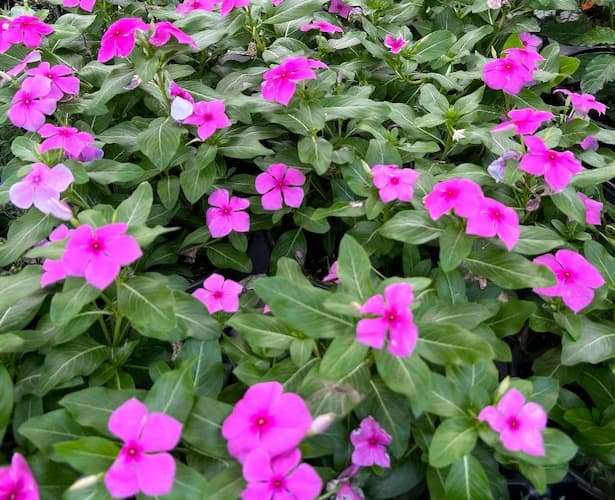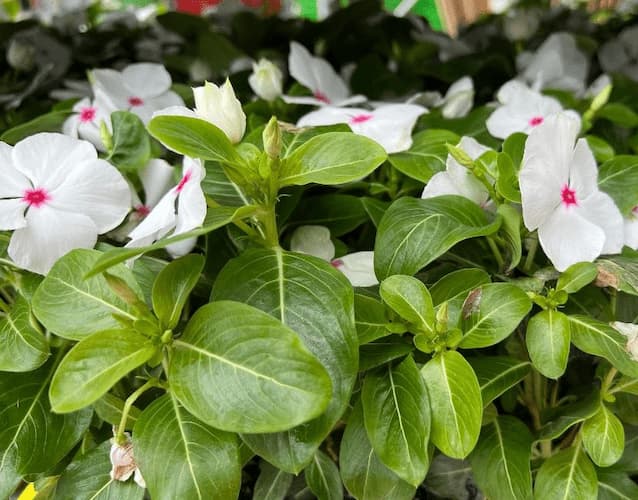How to Grow Vinca Flowers or Periwinkle

About Growing Vinca Flowers in Your Home Flower Garden
Vinca plants, or Periwinkle, is a prolific heat and drought tolerant annual. They are perfect for hot, dry areas. It’s easy to grow and requires little or no attention. A grower once reported that he has grown Vinca in the same location for 30 years. It successfully reseeded itself each year, with no effort on his part. This guide on “How to Grow Vinca Flowers” will help you to grow them year after year after year.
This plant is known by three names: Vinca, Periwinkle (or Madagascar Periwinkle), and Myrtle. Botanists will tell you that there is also a separate strain or variety of Periwinkle. Vinca plants are native to North America, Europe, China, and India.
The plants are grown for their attractive glossy, green foliage, as well as their flowers. Flowers bloom all summer, and up to frost. Common colors include white, rose, pink, and red.
Vinca is commonly used for borders, edging, and ground cover or bedding plants.
Vinca Flowers Plant Specifications
Flower Colors: Blue, lavender, pink, purple, rose, and white
Flowers Bloom: Spring through Summer
Plant height: Plants grow one to two feet tall.
Ideal Soil pH: 8.0 – 7.0.
Plant Hardiness Zones: 9 – 11
Light Needs: Full sunlight to partial sun.
Toxic Plant? Yes. This plant is harmful to people pets, and livestock.
Deer Resistant? Yes. Deer, rabbits, and other foraging animals do not like the bitter taste, and scent of this plant.
Number of Species: Twelve species.
Plant Type: Annual.
Native To: Northwest Africa, Europe, and Southwest Asia.
Botanical Name: Catharanthus roseus
Other Names: Periwinkle
Are Vinca Plants Edible?
NO!!
Vinca plants are harmful to humans, pets, livestock, and wildlife. Consumption can cause diarrhea, dizziness, gastrointestinal problems, nausea, and vomiting.
We recommend wearing gloves when working with this plant.
Medicinal Applications
Over the years, Vinca has been used for medicinal purposes. Applications included:
Lowering blood pressure
Lowering sugar levels for diabetics
Treatment for coughs, colds, sore throats
Treating eye and lung infections
Caution: Because this plant is toxic, we recommend you do not prepare these remedies yourself, unless you are properly trained to do so.
Light Requirements
Vinca flowers grow best in full, bright sunlight. Select a planting location where they will receive at least six to eight hours of direct sunlight. The plants tolerate a little partial sunlight. However, with too little sun, the plants become leggy and produce fewer flowers.
Annual Vinca Flower Plant Propagation
Vinca or Periwinkle are grown from seeds. Sow Vinca seeds outdoors after all danger of frost. Many people will broadcast spread them across an area. These prolific, self-seeders, will usually reseed themselves if left unattended.
You can also start them indoors 10 to 12 weeks before the last frost in your area.
Some varieties can also be propagated by rooting cuttings.
Note: For indoor starts, we recommend using a heated germination mat, to increase the speed of germination. And, it, results in a higher germination rate.
Final Plant Spacing: Space plants 10 – 12 inches apart.
Days to Germination: Seeds sprout in 14 – 21 days.

How to Grow Vinca Flower Plants
Planting location and soil needs:
Vinca or Periwinkle are excellent reseeders. So, select a planting location where they can grow undisturbed for many years. The plants will grow in a wide range of light conditions, from full sun to shade. They will do well in rich to average soils. Mix in compost to the planting site. Apply a general-purpose fertilizer after planting. Then, water the planting site.
Fertilizer needs:
In average soil, apply a general-purpose fertilizer every four to six weeks during the growing season. In rich soil, you can apply fertilizer a little less often. As flower buds begin to form, switch to a fertilizer high in phosphorous.
Water needs:
The plants are both heat and drought-tolerant. This makes Vinca ideal in hot, dry parts of the country where other flowers will wither and wilt.
Water well, when planting. Once plants are established, water only during extended droughts. Allow the soil to dry out between watering.
Other Steps:
Mulch around plants in dry areas to help retain soil moisture, and to create a neat appearance.
After the blooming period is over, you can pull up the plants and put them into your composter.
If you want them to reseed the area for next year, allow the plants to remain until the seed pods have dried, and opened up to spill their seeds.
Pruning
There is little or no pruning required. Simply remove the occasional dead or diseased leaves as you spot them.
Spent flower blooms will fall off quickly shortly after they have died. So, there is no need to deadhead the plants.
If you want to save some of the seeds to plant elsewhere or give to gardening friends, harvest the seeds before the seedpods open and spill the seeds onto the soil.
How to Grow Vinca Flowers in Containers and Flowerpots
Vinca flowers are great candidates to grow in flowerpots and containers. Try them in windowsill plants and hanging baskets, too.
In addition to the how to grow steps above, here are a few additional steps:
- Use rich planting soil for the container.
- Select a sunny location on your balcony or deck.
- It is important to have a drain hole in the container to allow excess water to drain from the pot.
- The plant grows best in moist to slightly dry soil.
- Allow the top of the soil in the planter to dry between watering.
- Keep an eye on the moisture level. Check the plants every few days, especially in extended periods of hot, dry weather.
- When watering the plants, thoroughly wet the soil. Excess water will drain through the hole in the bottom of the flowerpot.
- Nutrients in a flowerpot are limited. So, use fertilizer spikes to feed the plants. Or, apply a light solution of liquid fertilizer every two to three weeks.
Insects and Plant Disease
Annual Vinca plants are seldom bothered by insects and disease. Fungus problems can occur in humid or wet weather. If insect or disease problems occur, treat early with organic or chemical insect repellents and fungicide.
Also see: Plant Problems – Identify the causes and find the cures, too.
Related Articles
Also, people who read this article on Vinca flowers will like:
Please support our site. Shop for:
- rmmatthews100@hotmail.com
- 585-721-6528
- Rochester, NY
©1999-2024 GardenersNet.Com, All Rights Reserved

